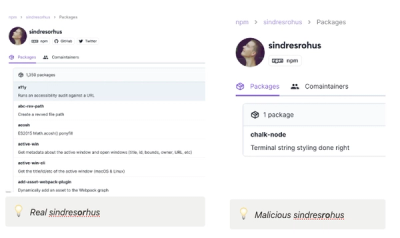
Security News
JSR Working Group Kicks Off with Ambitious Roadmap and Plans for Open Governance
At its inaugural meeting, the JSR Working Group outlined plans for an open governance model and a roadmap to enhance JavaScript package management.
opentok-react-native
Advanced tools

React Native library for using OpenTok.
This library is now officially supported by Vonage.
In this repo, you'll find the OpenTok React Native library.
In your terminal, change into your React Native project's directory
Add the library using npm or yarn.
npm install opentok-react-nativeyarn add opentok-react-nativeNote: Please make sure to have CocoaPods on your computer.
If you've installed this package before, you may need to edit your Podfile and project structure because the installation process has changed.
In you terminal, change into the ios directory of your React Native project.
Create a pod file by running: pod init.
For React Native < 0.60, add this to your Podfile:
target '<YourProjectName>' do
# Pods for <YourProject>
pod 'OTXCFramework', '2.26.1'
end
Now run, pod install
After installing the OpenTok iOS SDK, change into your root directory of your project.
For React Native < 0.60, now run react-native link opentok-react-native.
Open <YourProjectName>.xcworkspace contents in XCode. This file can be found in the ios folder of your React Native project.
Click File and New File
Add an empty swift file to your project:
OTInstall.swift. This is done to set some flags in XCode so the Swift code can be used.Click Create Bridging Header when you're prompted with the following modal: Would you like to configure an Objective-C bridging header?
Ensure you have enabled both camera and microphone usage by adding the following entries to your Info.plist file:
<key>NSCameraUsageDescription</key>
<string>Your message to user when the camera is accessed for the first time</string>
<key>NSMicrophoneUsageDescription</key>
<string>Your message to user when the microphone is accessed for the first time</string>
If you try to archive the app and it fails, please do the following:
In your terminal, change into your project directory.
If you have already run react-native link opentok-react-native for the iOS installation, please skip this step.
react-native link opentok-react-nativeOpen your Android project in Android Studio.
Sync Gradle
Make sure the following in your app's gradle compileSdkVersion, buildToolsVersion, minSdkVersion, and targetSdkVersion are greater than or equal to versions specified in the OpenTok React Native library.
As for the older Android devices, ensure you add camera and audio permissions to your AndroidManifest.xml file:
<uses-permission android:name="android.permission.CAMERA" />
<uses-permission android:name="android.permission.MODIFY_AUDIO_SETTINGS" />
<uses-permission android:name="android.permission.RECORD_AUDIO" />
<uses-feature android:name="android.hardware.camera" android:required="true" />
<uses-feature android:name="android.hardware.camera.autofocus" android:required="false" />
<uses-feature android:name="android.hardware.microphone" android:required="true" />
Newer versions of Android–API Level 23 (Android 6.0)–have a different permissions model that is already handled by this library.
Bintray support has ended (official announcement: https://jfrog.com/blog/into-the-sunset-bintray-jcenter-gocenter-and-chartcenter/). In your app build.gradle file you need to remove reference to jcenter and replace it with mavenCentral. Example:
// Top-level build file where you can add configuration options common to all sub-projects/modules.
buildscript {
...
repositories {
google()
mavenCentral()
}
...
}
allprojects {
repositories {
maven {
// All of React Native (JS, Obj-C sources, Android binaries) is installed from npm
url("$rootDir/../node_modules/react-native/android")
}
maven {
// Android JSC is installed from npm
url("$rootDir/../node_modules/jsc-android/dist")
}
mavenCentral {
// We don't want to fetch react-native from Maven Central as there are
// older versions over there.
content {
excludeGroup "com.facebook.react"
}
}
google()
maven { url 'https://www.jitpack.io' }
}
}
See the docs.
To see this library in action, check out the opentok-react-native-samples repo.
Interested in contributing? We :heart: pull requests! See the Contribution guidelines.
We love to hear from you so if you have questions, comments or find a bug in the project, let us know! You can either:
2.26.1 (October 2023)
[Update]: The new OTPublisher.setVideoTransformers() method lets you set (and clear)
video transformers, such as a background blur for a publisher (issues #631 and #682).
For more info, see the docs: OTPublisher.
[Update]: Live Captions API enhancements (issue #643)
The new OTPublisher.publishCaptions option lets you enable and disable captions for a published stream (if captions are enabled for the session). For more info, see the docs:OTPublisher.
The new OTSubscriber.subscribeToCaptions option lets you turn captions on and off for a subscriber (if captions are enabled for the session and the publisher is publishing captions). For more info, see the docs: OTSubscriber.
The new OTSubscriber captionReceived event is dispatched when a subscriber receives a caption. For more info, see the docs: OTSubscriber.
For more information, see the Live Captions developer guide.
[Fix]: Fixes an issue in which applications could not connect to a session when
the proxyUrl option for OTSession was set. - issue #645
[Fix]: Fixes an issue a stream is not destroyed immediately after unmounting an OTSession component or when the OTSession.disconnect() method is called. - issues #685 and #686
FAQs
React Native components for OpenTok iOS and Android SDKs
The npm package opentok-react-native receives a total of 1,963 weekly downloads. As such, opentok-react-native popularity was classified as popular.
We found that opentok-react-native demonstrated a healthy version release cadence and project activity because the last version was released less than a year ago. It has 5 open source maintainers collaborating on the project.
Did you know?

Socket for GitHub automatically highlights issues in each pull request and monitors the health of all your open source dependencies. Discover the contents of your packages and block harmful activity before you install or update your dependencies.

Security News
At its inaugural meeting, the JSR Working Group outlined plans for an open governance model and a roadmap to enhance JavaScript package management.

Security News
Research
An advanced npm supply chain attack is leveraging Ethereum smart contracts for decentralized, persistent malware control, evading traditional defenses.

Security News
Research
Attackers are impersonating Sindre Sorhus on npm with a fake 'chalk-node' package containing a malicious backdoor to compromise developers' projects.